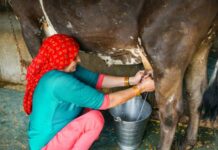New Delhi, November 22, 2024: Gujarat’s dairy sector, managed under the Gujarat Cooperative Milk Marketing Federation (GCMMF), continues to show impressive growth, with over 3.6 million farmer-members across 18,164 village cooperatives.
As per an official release, the state’s dairy network processes an astounding 215 million litres of milk daily, solidifying its position as a leader in India’s dairy industry.
In the fiscal year 2023-24, the sector achieved a remarkable annual turnover of Rs 80,000 crore, reflecting its robust expansion and the efficiency of its cooperative model.
The growth is further highlighted by Gujarat’s milk production, which has been increasing at a Compound Annual Growth Rate (CAGR) of 4.96 per cent, surpassing the national average of 4.57 per cent.
Shankar Chaudhary, Chairman of Banas Dairy, said, “After 2014, when Modi ji became the Prime Minister of the country, a separate ministry for cooperatives was established, and Amit Shah was entrusted with this responsibility. Cooperatives, where small people can come together and work collectively, were presented as a model for the country. I believe this Amul model and the cooperative model have not only proven successful for the country but for the entire world.”
He added, “As of today, 35 lakh dairy farming families are generating a turnover of Rs 80,000 crore (96 billion USD). The remarkable system, where money is deposited into their accounts, has been made possible through the Amul model, the use of technology, and transparency, which has been institutionalized through laws.”
The cooperative sector, which began in 1942, has been a major driver of Gujarat’s milk production. The dairy sector received a significant boost when Narendra Modi took over as the state’s Chief Minister in 2001.
He strengthened Gujarat’s dairy cooperatives through infrastructure development, technological advancements, support for women, promotion of the Amul brand, and policies that fostered self-sufficiency and growth in milk production.
A large number of farmers in Gujarat, especially those with small or no farmland, are engaged in dairy farming, significantly contributing to making Gujarat a role model for milk production in the country.
These small dairy farmers deposit their milk in local cooperative societies. From there, the milk is sent to a dairy for quality checks. Only when the quality of the milk is ensured is it sent to larger plants.
The entire process focuses on transparency and quality, ensuring that producers receive a fair price. This progress in Gujarat’s dairy industry is improving people’s lives.
Faljibhai Patel, a dairy farmer in Ruppura village, said, “The milk business is doing so well that even though there are no industries in our district, it has become the main source of livelihood along with farming. Through this, we manage our households, educate our children, and benefit from many government schemes implemented in the mandals. We also receive support from union-promoted schemes, such as installing chilling units, building houses, and more.”
Another dairy farmer, Jayeshbhai Limbachiya, said, “My name is Jayeshbhai Limbachiya, and we are residents of Ruppura village. There is a very good milk dairy running in our village, and the whole village contributes milk to it. The profit from milk is very good. Banas Dairy, our main branch, is located here, and the government is also helping us a lot. We are benefiting from many schemes. Even those who do not have land are successfully running a milk business, managing their livelihood, and earning good profits.”
Gujarat played a key role in India’s White Revolution by pioneering the cooperative dairy model, leading to the establishment of Amul.
Today, it stands as a role model in milk production, with its efficient cooperative system, technological advancements, and significant contributions to both national and global milk supply according to the reports published in thenewsmill.com.
The state’s innovative approach has made it the leading producer of milk in India.

























